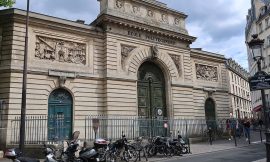Exhibitions in Paris and the Return of European Tourists
Van Gogh, Modigliani, De Stael, Picasso, Rothko… This autumn, the major Parisian museums are hosting prestigious exhibitions that are expected to once again boost the arrival of tourists in the French capital.
Van Gogh at the Musée d’Orsay A
In Auvers-sur-Oise, Van Gogh experimented with new formats to depict the vast landscapes of the Vexin region (Photo PB).
The vast green landscapes, immense wheat fields, thatched houses, and cloudy skies of the French Vexin region, around Auvers-sur-Oise, a town located half an hour from Paris, are on display at the Musée d’Orsay in Paris since October 3rd. This museum, located in a former train station on the banks of the Seine, is hosting an exhibition dedicated to Vincent Van Gogh’s work during the last two months of his life until February 4th. The painter arrived in Auvers-sur-Oise on May 20th and died on July 29th, 1890, two days after shooting himself in the chest.
First presented this year at the Van Gogh Museum in Amsterdam, this exhibition is the first major one dedicated to the artist’s last works. Having been severely affected by several crises of madness during his stay in Arles, and then during his voluntary internment in the asylum of Saint-Remy de Provence for a year, Vincent van Gogh wanted to get closer to Paris and his brother Theo, an art dealer, in the hopes of soothing his anguish and finding a new creative impulse.
He chose Auvers-sur-Oise because of the presence of Doctor Gachet in this village, a physician specialized in the treatment of “melancholy” and a friend of the Impressionist painters, collector, and amateur painter himself. Installed in the center of the town, at the Ravoux Inn, Van Gogh worked tirelessly and produced no less than 73 paintings and 33 drawings, including iconic masterpieces such as the portrait of “Doctor Paul Gachet,” “The Church of Auvers-sur-Oise,” and “Wheatfield with Crows.”
The Musée d’Orsay exhibition presents around forty paintings and twenty drawings from this period. The compositions are simple, the brushstrokes daring and expressive, the colors vibrant… Van Gogh also experiments with new themes and formats.
The genius of the Dutch painter is at its peak. As evidenced by the last canvas he painted on the day of his suicide: this almost abstract composition depicting an interlacing of bare roots, framed very closely like a photographer’s close-up, carries a clear symbolic charge. A few days earlier, Van Gogh wrote, “my own life is attacked at its very root”…
Modigliani at the Musée de l’Orangerie
This interlacing of bare roots, framed very closely, is the last work painted by Van Gogh before his suicide (Photo PB). This exhibition decodes the last artistic production – still relatively unknown – of a Van Gogh acclaimed by both connoisseurs and the general public. Clearly, crowds will flock to the Musée d’Orsay. The same is expected for the autumn exhibition at the nearby Musée de l’Orangerie, on the edge of the Tuileries Garden. It is dedicated to Amedeo Modigliani since September 20th (until January 15th) and is titled “A Painter and his Dealer.”
Indeed, this exhibition was created through the prism of the relationship between the Italian-born painter, who settled in Paris in 1906, and his first art dealer, Paul Guillaume. As it is not very generous in terms of artworks, it may leave already knowledgeable Modigliani fans wanting more. However, this more intimate portrait of Modigliani and Paul Guillaume, his dealer, is expected to satisfy many. The two men shared artistic and literary affinities – both were also sensitive to poetry – and had a common interest in African art. Furthermore, the exhibition provides a good illustration of the artistic and Parisian context of the 1910s and 1920s.
And also De Stael, Rothko, and many others
This is the only nude by Modigliani presented at the Musée de l’Orangerie (Photo PB).
The Museum of Modern Art of the City of Paris has been attracting art lovers with a stunning retrospective of the Franco-Russian painter Nicolas de Staël since September 15th (until January 21st). This exhibition, which includes many previously unseen works, departs from the myth of the tormented artist and highlights the complexity of an artist constantly in search of “truly continuous renewal.” This indispensable painter of the French artistic scene after the Second World War is still relatively unknown. Settled in Antibes, driven by creative frenzy but desperate due to his unrequited love for Jeanne Mathieu, he committed suicide there on March 16th, 1955, at the age of 41, leaving behind a vivid red, six-meter-long canvas featuring a piano and a double bass.
In these later southern works, his once thick, stratified painting gives way to furious, vibrant landscapes filled with bright colors, passion, and life, as well as larger fluid formats, blue horizons, and sensitive images without superfluous details…
Another equally exceptional retrospective will be dedicated to the American painter Mark Rothko (1903-1970) from October 18th (until April 2nd, 2024) at the Fondation Louis Vuitton in Paris. This exhibition is the first retrospective in France dedicated to this major artist since the one held at the Musée d’Art Moderne de la Ville de Paris in 1999. It brings together around 115 works from the most significant institutional collections, including the National Gallery of Art in Washington, the Tate in London, and the Phillips Collection in Washington, as well as major private international collections including that of the artist’s family. It unfolds in all the spaces of the Foundation, following a chronological route, and traces the artist’s entire career from his early figurative paintings to the abstraction that now defines his work.
Exhibitions in Paris, an Undeniable Vector for Tourism
Last winter, the exhibition dedicated to the Viennese artist Oskar Kokoschka at the Museum of Modern Art of the City of Paris attracted more than 200,000 visitors (Photo PB). It is difficult to provide a comprehensive overview of the exhibitions in Paris this autumn, as there are many headliners. However, let us mention “Picasso. 2023 Drawings” at the Centre Pompidou, the madness of “Bollywood: A Story of Indian Cinema” at the Musée du Quai Branly, the exhibition dedicated to the brilliant Claude Gillot, a master of Antoine Watteau, at the Louvre Museum, or finally the “Masters of Black” at the Petit Palais. This rich and appealing program of exhibitions in Paris is expected to confirm the upswing for the city’s museums. Already, 2022, marked by the return of European tourists in particular, had brought a smile to the faces of the major Parisian institutions despite the still visible absence of Asian audiences. Their attendance had almost reached the level of 2019, before the Covid pandemic.
Last year, the increase in attendance was driven by successful exhibitions such as the Norwegian painter Munch at the Musée d’Orsay (with over 600,000 visitors three weeks before its closure), the Mexican artist Frida Kahlo at the Palais Galliera, and the Viennese



